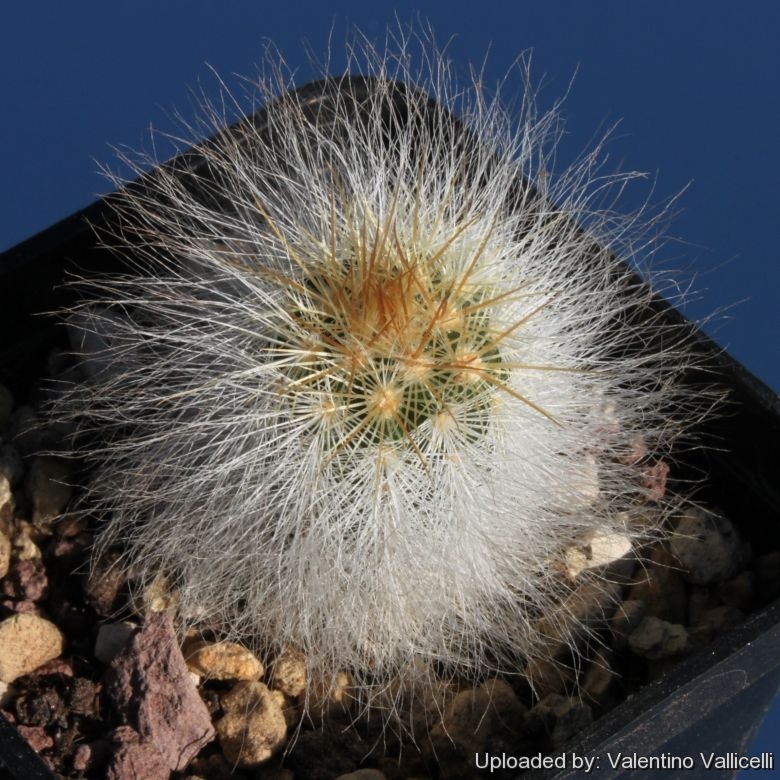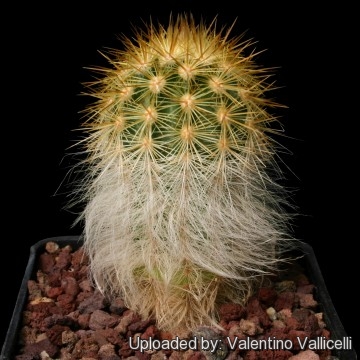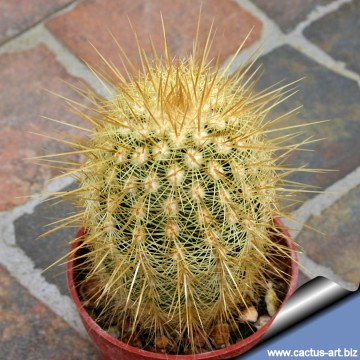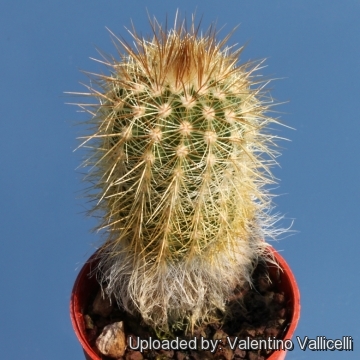Accepted Scientific Name: Echinocereus viridiflorus subs. chloranthus (Engelm.) N.P.Taylor
Cactaceae Consensus Init. 3: 10. 1997

Echinocereus viridiflorus var. neocapillus Photo by: Valentino Vallicelli
This species has an upright solitary stem with dense golden spines and greenish flowers,
it is remarkable for its softly hairlike, not sharply spiny, seedlings.
Origin and Habitat: Small area south of Marathon, West Texas in Brewster County, about 150 miles south-east the typical Echinocereus viridiflorus var. chloranthusSN|7817]]SN|7770]].
Altitude: 1100-1500 metres above sea level.
Habitat: It grow on hills over novaculite outcrops among grasses. Associates cactus species include include Opuntia rnacrocentra, Echinocereus stramineusSN|7770]]SN|7817]], Escobaria hesteriSN|10222]]SN|10222]], Thelocactus bicolorSN|3420]]SN|3420]] var. flavidispinus and Mammillaria heyderiSN|20805]]SN|20805]]. In the same area it is also possible to find a spare shrubby and herbaceous vegetation comprising: Viguiera stenoloha, Selaginella peruviana, Acacia constricta, Bouteloua ramosa, Dasyochloa pulchella, Larrea tridentata, Agave lechuguillaSN|23013]]SN|23013]], Yucca elata, Yucca torreyi, Dasylirion leiophyllum, Nolina texana, Zinnia acerosa, and Thymophylla pentachaeta.
Synonyms:
See all synonyms of Echinocereus viridiflorus
Common Names include:
ENGLISH: Goldspine Edghog Cactus., Woolly Edgehog, Weninger's Small Flowerered Hedhog Cactus, Long Haired Green Flowered Pitaya, Golden Spine Edgehog
Description: It is a perennial stem succulent usually simple or branching, but older plants may exhibit limited branching above.
Similar species: Echinocereus viridiflorusSN|7770]]SN|11071]] var. neocapillus is somewhat like Echinocereus viridiflorus var. chloranthusSN|7770]]SN|7770]], but with immature plants or new branches covered with very distictive, white, flexible hairs. The yellow or white spines are produced only when plants attain an height of 3-5 cm. Bases of older plants often show belt of white wool, with typical spines above. The juvenile stage, with long, white, hair-like spines, is considered characteristic, young plants of typical chloranthus never have hairs. Spines of adult specimens are very similar to those of Echinocereus viridiflorus var. chloranthusSN|11071]]SN|7770]], but fewer (15-23). Moreover the radial spines cover surface of stem much more than do those of typical form, and centrals are more numerous and somewhat shorter. However, hairy juvenile forms are not exclusively of Echinocereus viridiflorusSN|11071]]SN|11071]] var. neocapillus, as this peculiar characteristic is also found in Echinocereus milleriSN|25592]]SN|25592]], which has fewer radial spines (18-24) and fewer central spines (2-4) and Echinocereus viridiflorusSN|11071]]SN|11071]] var. canus, wich has more radial spines (30-48) and fewer central spines (8-15). The var. neocapillus intergrades with Echinocereus viridiflorusSN|7770]]SN|11071]] var. corelli at the morthern margin of its range.
Stem: Cylindrical, erect, pale or yellowish-green, 8-25 cm tall, 3-7 cm in diameter.
Ribs: 12-18, often nearly hidden by the densely set spines, , low, with distinct tubercles.
Areoles: Round to oval and 3-5 mm long, and up to 6 mm apart on the ribs. covered with much white or yellowish wool when young, bare when old except for very small tuft at upper end of areole where flower is produced.
Central spines: 5-11, not angled, stronger than radials straight, spreading in all directions from centre of areole, uppermost 3-6 mm long, slender; rest heavier, 6-18(-27) mm long, translucent yellow, white or light brown, often with reddish tip, or occasionally all reddish.
Radial spines: Several (26-)30-38(-45), straight, slender, tightly appressed, evenly radiating around the areoles, often crowded, interlocking with spines from other areoles, upper very slender, 3 mm long; length increases around areole; laterals to 6 mm long, lower ones slightly shorter, clear translucent yellow, light brown or chalk-white, all of an areole being same colour, and forming annual horizontal dark and light bands, (yellow, tan or light browm and white) around the stem on older plants. In juvenile plants the radial spines are short, pectinate, and appressed, except in turgid seedlings, where the radials may be spreading. All the spines has a bulbous base but usually covered, until they are very old, by the wool of the areoles.
Juvenile specimens Immature plants or new branches have no spines, but have thick covering of white, very fine, flexible hairs 6-30 (or more) mm long, 40 hairs per areole, when plant 2,5-5 cm tall, normal spines begin appearing at tip of stem; juvenile hairs often persisting at bases of older specimens.
Flowers: As in Echinocereus viridiflorus var. chloranthusSN|7770]]SN|7770]]. Diurnal, produced on lateral midstems, but sometime lower, funnelform, not opening widely, 25-32 mm long, 15-25 mm in diameter, dark green, yellowish green, bronze-green, brown or dark chocolate-brown. Usually the lemon scent of other related taxa. Ovary with white wool and white spines about 6-12 mm long. Inner perianth segments linear, edges entire, sharply pointed, not broadening throughout their length brownish-green or rusty and greener toward the center, often with dark green midlines with the margins lighter green and suffused with brown. Outer perianth segments often with brownish midlines and margins olive-yellow. Filaments pale yellow or greenish. Anthers cream coloured or yellow. Stile greenish, 1,2-2 cm long. Stigma lobes 8-10 dark green.
Blooming season: Spring for 15-30 days ( in habitat from March through May), The flowers open again for 3-4 days after closing at night. Individual plants or stems may produce more than 30 flowers at a time.
Fruits: As in Echinocereus viridiflorus var. chloranthusSN|11071]]SN|7770]]. Small, dry, nearly globular, 2-14 mm long, 7-10 mm in diameter, green (or dull purplish red), indehiscent, covered with small bristly spines, that easily fall away, leaving a glistening fruit wall. When the fruit mature they split open.
Seeds: 0,9-1,2 mm long and wide , black, papillate (warty), the hilum nearly basal, round.
Chromosome number: 2n = 22
Subspecies, varieties, forms and cultivars of plants belonging to the Echinocereus viridiflorus/russanthus complex
 Echinocereus carmenensis W.Blum, Mich.Lange & E.Scherer in W.Blum et al.: has stocky body covered by tight yellowish pectinate spines and peculiar chocolate-scented flowers. Distribution: La Cuesta, passo Sierra del Carmem, Coahuila, Mexico.
Echinocereus carmenensis W.Blum, Mich.Lange & E.Scherer in W.Blum et al.: has stocky body covered by tight yellowish pectinate spines and peculiar chocolate-scented flowers. Distribution: La Cuesta, passo Sierra del Carmem, Coahuila, Mexico. Echinocereus milleri W.Blum, Kuenzler & Oldach: has the "hairy" seedlings of Echinocereus viridiflorus var. neocapillus, but has fewer spines it is also similar to the yellow spined Echinocereus viridiflorus subs. Correllii (which it obviously is not).
Echinocereus milleri W.Blum, Kuenzler & Oldach: has the "hairy" seedlings of Echinocereus viridiflorus var. neocapillus, but has fewer spines it is also similar to the yellow spined Echinocereus viridiflorus subs. Correllii (which it obviously is not). Echinocereus russanthus D.Weniger: has spheric to cylindrical stems, 8-30 tall and 4-8 cm Ø; ribs 10-20. Spines: Interlocking, bristly, typically reddish to brown, radiating in all directions. Distribution: Chihuahua (Mexico) and N-W Texas (USA).
Echinocereus russanthus D.Weniger: has spheric to cylindrical stems, 8-30 tall and 4-8 cm Ø; ribs 10-20. Spines: Interlocking, bristly, typically reddish to brown, radiating in all directions. Distribution: Chihuahua (Mexico) and N-W Texas (USA). Echinocereus russanthus f. cristata hort.: crested form.
Echinocereus russanthus f. cristata hort.: crested form. Echinocereus russanthus subs. fiehnii (Trocha) W.Blum & Mich.Lange: Distribution: endemic to the Sierra del Nido, central Chihuahua, Mexico.
Echinocereus russanthus subs. fiehnii (Trocha) W.Blum & Mich.Lange: Distribution: endemic to the Sierra del Nido, central Chihuahua, Mexico.- Echinocereus russanthus subs. weedinii Leuck ex W.Blum & Mich.Lange in W.Blum et al.
 Echinocereus viridiflorus Engelm. in Wisliz.: ssp. viridiflorus (Typical form) With small stems and relatively pure yellow flowers, extends from central New Mexico and the Texas Panhandle to South Dakota.
Echinocereus viridiflorus Engelm. in Wisliz.: ssp. viridiflorus (Typical form) With small stems and relatively pure yellow flowers, extends from central New Mexico and the Texas Panhandle to South Dakota. Echinocereus viridiflorus var. canus A.M.Powell & Weedin: has hairy juvenile forms. Distribution: Solitario, Sandstone ridge above Righthand Shutup, Presidio Co., Texas, USA.
Echinocereus viridiflorus var. canus A.M.Powell & Weedin: has hairy juvenile forms. Distribution: Solitario, Sandstone ridge above Righthand Shutup, Presidio Co., Texas, USA. Echinocereus viridiflorus subs. chloranthus (Engelm.) N.P.Taylor: has 10-18 ribs, 5 or more central spines, giving the plants a bristly appearance, it is often considered a separate species (Echinocereus chloranthus). Distribution: W. Texas, S.E. New Mexico, and N. Mexico.
Echinocereus viridiflorus subs. chloranthus (Engelm.) N.P.Taylor: has 10-18 ribs, 5 or more central spines, giving the plants a bristly appearance, it is often considered a separate species (Echinocereus chloranthus). Distribution: W. Texas, S.E. New Mexico, and N. Mexico. Echinocereus viridiflorus subs. correllii (L.D.Benson) W.Blum & Mich.Lange in W.Blum et al.: It is a poorly defined, yellow-spined population near Marathon, Texas.
Echinocereus viridiflorus subs. correllii (L.D.Benson) W.Blum & Mich.Lange in W.Blum et al.: It is a poorly defined, yellow-spined population near Marathon, Texas. Echinocereus viridiflorus cowperii n.n.: same as: Echinocereus viridiflorus var. rhyolithensis.
Echinocereus viridiflorus cowperii n.n.: same as: Echinocereus viridiflorus var. rhyolithensis. Echinocereus viridiflorus subs. cylindricus (Engelm.) N.P.Taylor: The common morphotype grows at middle altitudes in Texas and southeastern New Mexico, it has 0-2(-3) central spines.
Echinocereus viridiflorus subs. cylindricus (Engelm.) N.P.Taylor: The common morphotype grows at middle altitudes in Texas and southeastern New Mexico, it has 0-2(-3) central spines. Echinocereus viridiflorus subs. davisii (Houghton) N.P.Taylor: In the broad sense Echinocereus viridiflorus may prove paraphyletic with respect to Echinocereus davisii, but they are phenologically isolated, with Echinocereus davisii flowering earlier and thus appearing reproductively isolated in the wild.
Echinocereus viridiflorus subs. davisii (Houghton) N.P.Taylor: In the broad sense Echinocereus viridiflorus may prove paraphyletic with respect to Echinocereus davisii, but they are phenologically isolated, with Echinocereus davisii flowering earlier and thus appearing reproductively isolated in the wild. Echinocereus viridiflorus subs. davisii cv. brevispinus hort.: has very short spines, usually radial, pectinated, stout, fang like, white whit a dark contrasting tip 2-4 mm long. Spine clusters looks like small starfishes.
Echinocereus viridiflorus subs. davisii cv. brevispinus hort.: has very short spines, usually radial, pectinated, stout, fang like, white whit a dark contrasting tip 2-4 mm long. Spine clusters looks like small starfishes. Echinocereus viridiflorus var. montanus hort.: has significantly depressed stems solitary or in low clusters (mostly less than 2 cm tall). Distribution: Southwestern USA (Monarch Pass, Colorado?)
Echinocereus viridiflorus var. montanus hort.: has significantly depressed stems solitary or in low clusters (mostly less than 2 cm tall). Distribution: Southwestern USA (Monarch Pass, Colorado?) Echinocereus viridiflorus var. neocapillus (D.Weniger) A.D.Zimmerman: Remarkable for its softly hairy, not sharply spiny, seedlings.
Echinocereus viridiflorus var. neocapillus (D.Weniger) A.D.Zimmerman: Remarkable for its softly hairy, not sharply spiny, seedlings.- Echinocereus viridiflorus var. rhyolithensis W. Blume & Mich.Lange: (Echinocereus russantus forma) Bristly red-spined plants from New Mexico.
 Echinocereus viridiflorus var. robustior Kuenzler: It is a more robust form but not sufficiently differentiated and considered merely a local variant of Echinocereus viridiflorus var viridiflorus. Distribution New Mexico.
Echinocereus viridiflorus var. robustior Kuenzler: It is a more robust form but not sufficiently differentiated and considered merely a local variant of Echinocereus viridiflorus var viridiflorus. Distribution New Mexico.
Notes: Echinocereus neocapillusSN|11071]]SN|11089]] is part of the Echinocereus viridiflorusSN|11089]]SN|11071]] complex that comprises a large number of infraspecific taxa, differing in various combinations of flower color, spine color, number and thickness of central spines, and other characters, including floral scent. Wherever such taxa are sympatric they intergrade; all are freely interfertile in the greenhouse.
Bibliography: Major references and further lectures
1) Edward Anderson “The Cactus family” Timber Press, Incorporated, 2001
2) James Cullen, Sabina G. Knees, H. Suzanne Cubey "The European Garden Flora Flowering Plants: A Manual for the Identification of Plants Cultivated in Europe, Both Out-of-Doors and Under Glass" Cambridge University Press, 11/Aug/2011
3) David R Hunt; Nigel P Taylor; Graham Charles; International Cactaceae Systematics Group. "The New Cactus Lexicon" dh books, 2006
4) Brian Loflin, Shirley Loflin “Texas Cacti: A Field Guide” Texas A&M University Press, 26/ott/2009
5) Albert Michael Powell, James F. Weedin “Cacti of the Trans-Pecos and Adjacent Areas” Texas Tech University Press, 2004
6) Del Weniger “Cacti of the Southwest: Texas, New Mexico, Oklahoma, Arkansas, and Louisiana” University of Texas Press, 1969
7) Jackie M. Poole, William R. Sarr, Dana M. Price,& Jason R. Singhurst, “Rare Plants of Texas: A Field Guide” Texas A&M University Press, 2007
 Echinocereus viridiflorus var. neocapillus Photo by: Valentino Vallicelli
Echinocereus viridiflorus var. neocapillus Photo by: Valentino Vallicelli Echinocereus viridiflorus var. neocapillus Photo by: Cactus Art
Echinocereus viridiflorus var. neocapillus Photo by: Cactus Art Echinocereus viridiflorus var. neocapillus Photo by: Valentino Vallicelli
Echinocereus viridiflorus var. neocapillus Photo by: Valentino VallicelliSend a photo of this plant.The gallery now contains thousands of pictures, however it is possible to do even more. We are, of course, seeking photos of species not yet shown in the gallery but not only that, we are also looking for better pictures than those already present.
Read More... Cultivation and Propagation: In culture it is without problems and regularly shows its small greenish flowers if we provide an adequate winter rest period. They are re small plants with scented flowers that are better close to nose level. Displaying your cacti on shelves has the added benefit of keeping them off the ground and away from potential rodent or snail damage.
Soil: Use mineral well-permeable substratum with little organic matter (peat, humus). Repotting: Repotting every 2-3 years. It will need a pot with sufficient depth to allow the tap root. As it is especially prone to rot under-pot in a smaller container filled with very porous compost. Use pot with good drainage.
Watering: Water sparingly from March till October, and keep perfectly dry in winter, at temperatures from 5 to 15 degrees centigrade. In the rest period no high atmospheric humidity!!Care must be taken with watering as they tends to become swollen and untidy in growth habit if given too much water and shade.
Exposition: Outside bright sun, filtered sunlight or afternoon shade, inside it needs bright light, and some direct sun. Subject to sunburn if exposed to direct sun for too long. Tends to bronze in strong light, which encourages flowering and heavy spine production.
Hardiness: Keep drier and cool in winter. Very cold resistant hardy to -10° C or less for short periods of time.
Fertilization: During the growing season enrich the soil using a fertilizer rich in potassium and phosphorous, but poor in nitrogen, because this chemical element doesn’t help the development of succulent plants, making them too soft and full of water.
Pests & diseases: It may be attractive to a variety of insects, but plants in good condition should be nearly pest-free, particularly if they are grown in a mineral potting-mix, with good exposure and ventilation. Nonetheless, there are several pests to watch for:
- Red spiders: Sensitive to red spider mite. Overhead watering is helpful in controlling mites.
- Mealy bugs: Occasionally mealy bugs they develop aerial into the new growth among the wool with disfiguring results, but the worst types develop underground on the roots and are invisible except by their effects.
- Scales: Scales are rarely a problem.
- Rot: Rot it is only a minor problem with cacti if the plants are watered and “aired” correctly. If they are not, fungicides won't help all that much.
Propagation: Seeds or cutting (if available). Seeds germinate in 7-14 days at 21-27° C in spring, remove the glass cover gradually as the plants develops and keep ventilated, no full sun for young plants! The seedlings should not be disturbed until they are well rooted, after which they can be planted separately in small pots.













